Dahuin Jung
Know "No" Better: A Data-Driven Approach for Enhancing Negation Awareness in CLIP
Jan 19, 2025Abstract:While CLIP has significantly advanced multimodal understanding by bridging vision and language, the inability to grasp negation - such as failing to differentiate concepts like "parking" from "no parking" - poses substantial challenges. By analyzing the data used in the public CLIP model's pre-training, we posit this limitation stems from a lack of negation-inclusive data. To address this, we introduce data generation pipelines that employ a large language model (LLM) and a multimodal LLM to produce negation-inclusive captions. Fine-tuning CLIP with data generated from our pipelines, we develop NegationCLIP, which enhances negation awareness while preserving the generality. Moreover, to enable a comprehensive evaluation of negation understanding, we propose NegRefCOCOg-a benchmark tailored to test VLMs' ability to interpret negation across diverse expressions and positions within a sentence. Experiments on various CLIP architectures validate the effectiveness of our data generation pipelines in enhancing CLIP's ability to perceive negation accurately. Additionally, NegationCLIP's enhanced negation awareness has practical applications across various multimodal tasks, demonstrated by performance gains in text-to-image generation and referring image segmentation.
Textual Training for the Hassle-Free Removal of Unwanted Visual Data
Sep 30, 2024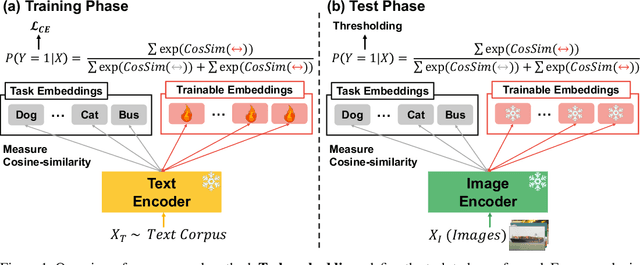
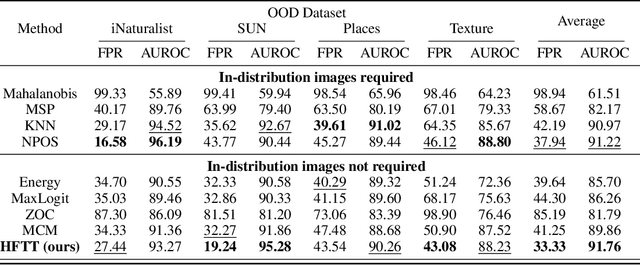
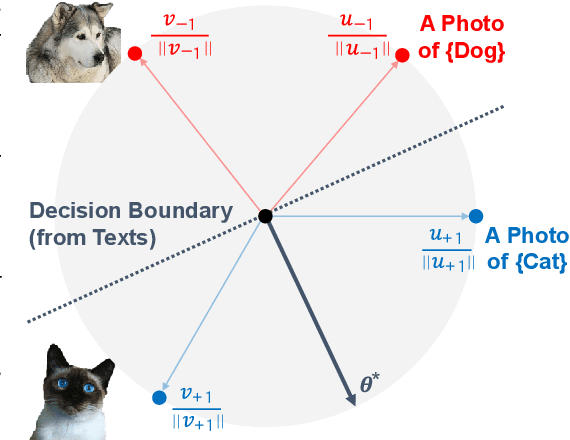

Abstract:In our study, we explore methods for detecting unwanted content lurking in visual datasets. We provide a theoretical analysis demonstrating that a model capable of successfully partitioning visual data can be obtained using only textual data. Based on the analysis, we propose Hassle-Free Textual Training (HFTT), a streamlined method capable of acquiring detectors for unwanted visual content, using only synthetic textual data in conjunction with pre-trained vision-language models. HFTT features an innovative objective function that significantly reduces the necessity for human involvement in data annotation. Furthermore, HFTT employs a clever textual data synthesis method, effectively emulating the integration of unknown visual data distribution into the training process at no extra cost. The unique characteristics of HFTT extend its utility beyond traditional out-of-distribution detection, making it applicable to tasks that address more abstract concepts. We complement our analyses with experiments in out-of-distribution detection and hateful image detection. Our codes are available at https://github.com/Saehyung-Lee/HFTT
Normality Addition via Normality Detection in Industrial Image Anomaly Detection Models
Jul 29, 2024



Abstract:The task of image anomaly detection (IAD) aims to identify deviations from normality in image data. These anomalies are patterns that deviate significantly from what the IAD model has learned from the data during training. However, in real-world scenarios, the criteria for what constitutes normality often change, necessitating the reclassification of previously anomalous instances as normal. To address this challenge, we propose a new scenario termed "normality addition," involving the post-training adjustment of decision boundaries to incorporate new normalities. To address this challenge, we propose a method called Normality Addition via Normality Detection (NAND), leveraging a vision-language model. NAND performs normality detection which detect patterns related to the intended normality within images based on textual descriptions. We then modify the results of a pre-trained IAD model to implement this normality addition. Using the benchmark dataset in IAD, MVTec AD, we establish an evaluation protocol for the normality addition task and empirically demonstrate the effectiveness of the NAND method.
Disentangled Motion Modeling for Video Frame Interpolation
Jun 25, 2024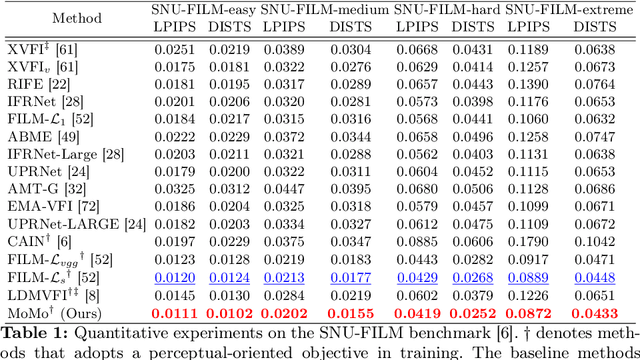
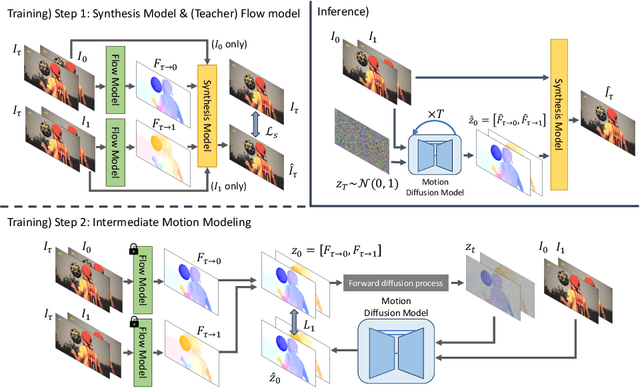

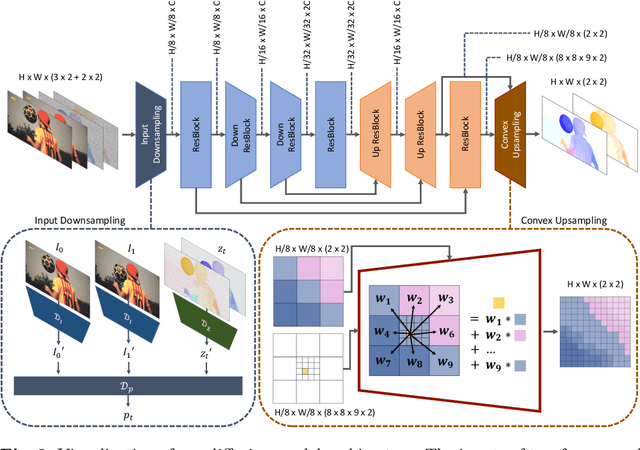
Abstract:Video frame interpolation (VFI) aims to synthesize intermediate frames in between existing frames to enhance visual smoothness and quality. Beyond the conventional methods based on the reconstruction loss, recent works employ the high quality generative models for perceptual quality. However, they require complex training and large computational cost for modeling on the pixel space. In this paper, we introduce disentangled Motion Modeling (MoMo), a diffusion-based approach for VFI that enhances visual quality by focusing on intermediate motion modeling. We propose disentangled two-stage training process, initially training a frame synthesis model to generate frames from input pairs and their optical flows. Subsequently, we propose a motion diffusion model, equipped with our novel diffusion U-Net architecture designed for optical flow, to produce bi-directional flows between frames. This method, by leveraging the simpler low-frequency representation of motions, achieves superior perceptual quality with reduced computational demands compared to generative modeling methods on the pixel space. Our method surpasses state-of-the-art methods in perceptual metrics across various benchmarks, demonstrating its efficacy and efficiency in VFI. Our code is available at: https://github.com/JHLew/MoMo
Efficient Diffusion-Driven Corruption Editor for Test-Time Adaptation
Mar 19, 2024Abstract:Test-time adaptation (TTA) addresses the unforeseen distribution shifts occurring during test time. In TTA, both performance and, memory and time consumption serve as crucial considerations. A recent diffusion-based TTA approach for restoring corrupted images involves image-level updates. However, using pixel space diffusion significantly increases resource requirements compared to conventional model updating TTA approaches, revealing limitations as a TTA method. To address this, we propose a novel TTA method by leveraging a latent diffusion model (LDM) based image editing model and fine-tuning it with our newly introduced corruption modeling scheme. This scheme enhances the robustness of the diffusion model against distribution shifts by creating (clean, corrupted) image pairs and fine-tuning the model to edit corrupted images into clean ones. Moreover, we introduce a distilled variant to accelerate the model for corruption editing using only 4 network function evaluations (NFEs). We extensively validated our method across various architectures and datasets including image and video domains. Our model achieves the best performance with a 100 times faster runtime than that of a diffusion-based baseline. Furthermore, it outpaces the speed of the model updating TTA method based on data augmentation threefold, rendering an image-level updating approach more practical.
Entropy is not Enough for Test-Time Adaptation: From the Perspective of Disentangled Factors
Mar 12, 2024Abstract:Test-time adaptation (TTA) fine-tunes pre-trained deep neural networks for unseen test data. The primary challenge of TTA is limited access to the entire test dataset during online updates, causing error accumulation. To mitigate it, TTA methods have utilized the model output's entropy as a confidence metric that aims to determine which samples have a lower likelihood of causing error. Through experimental studies, however, we observed the unreliability of entropy as a confidence metric for TTA under biased scenarios and theoretically revealed that it stems from the neglect of the influence of latent disentangled factors of data on predictions. Building upon these findings, we introduce a novel TTA method named Destroy Your Object (DeYO), which leverages a newly proposed confidence metric named Pseudo-Label Probability Difference (PLPD). PLPD quantifies the influence of the shape of an object on prediction by measuring the difference between predictions before and after applying an object-destructive transformation. DeYO consists of sample selection and sample weighting, which employ entropy and PLPD concurrently. For robust adaptation, DeYO prioritizes samples that dominantly incorporate shape information when making predictions. Our extensive experiments demonstrate the consistent superiority of DeYO over baseline methods across various scenarios, including biased and wild. Project page is publicly available at https://whitesnowdrop.github.io/DeYO/.
On the Powerfulness of Textual Outlier Exposure for Visual OoD Detection
Oct 25, 2023Abstract:Successful detection of Out-of-Distribution (OoD) data is becoming increasingly important to ensure safe deployment of neural networks. One of the main challenges in OoD detection is that neural networks output overconfident predictions on OoD data, make it difficult to determine OoD-ness of data solely based on their predictions. Outlier exposure addresses this issue by introducing an additional loss that encourages low-confidence predictions on OoD data during training. While outlier exposure has shown promising potential in improving OoD detection performance, all previous studies on outlier exposure have been limited to utilizing visual outliers. Drawing inspiration from the recent advancements in vision-language pre-training, this paper venture out to the uncharted territory of textual outlier exposure. First, we uncover the benefits of using textual outliers by replacing real or virtual outliers in the image-domain with textual equivalents. Then, we propose various ways of generating preferable textual outliers. Our extensive experiments demonstrate that generated textual outliers achieve competitive performance on large-scale OoD and hard OoD benchmarks. Furthermore, we conduct empirical analyses of textual outliers to provide primary criteria for designing advantageous textual outliers: near-distribution, descriptiveness, and inclusion of visual semantics.
PUCA: Patch-Unshuffle and Channel Attention for Enhanced Self-Supervised Image Denoising
Oct 16, 2023Abstract:Although supervised image denoising networks have shown remarkable performance on synthesized noisy images, they often fail in practice due to the difference between real and synthesized noise. Since clean-noisy image pairs from the real world are extremely costly to gather, self-supervised learning, which utilizes noisy input itself as a target, has been studied. To prevent a self-supervised denoising model from learning identical mapping, each output pixel should not be influenced by its corresponding input pixel; This requirement is known as J-invariance. Blind-spot networks (BSNs) have been a prevalent choice to ensure J-invariance in self-supervised image denoising. However, constructing variations of BSNs by injecting additional operations such as downsampling can expose blinded information, thereby violating J-invariance. Consequently, convolutions designed specifically for BSNs have been allowed only, limiting architectural flexibility. To overcome this limitation, we propose PUCA, a novel J-invariant U-Net architecture, for self-supervised denoising. PUCA leverages patch-unshuffle/shuffle to dramatically expand receptive fields while maintaining J-invariance and dilated attention blocks (DABs) for global context incorporation. Experimental results demonstrate that PUCA achieves state-of-the-art performance, outperforming existing methods in self-supervised image denoising.
Improving Visual Prompt Tuning for Self-supervised Vision Transformers
Jun 08, 2023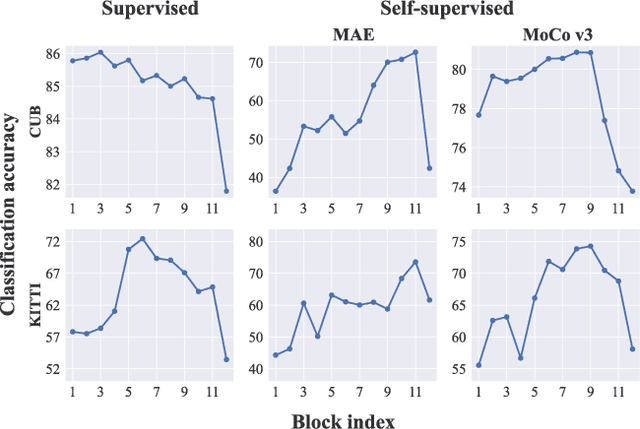

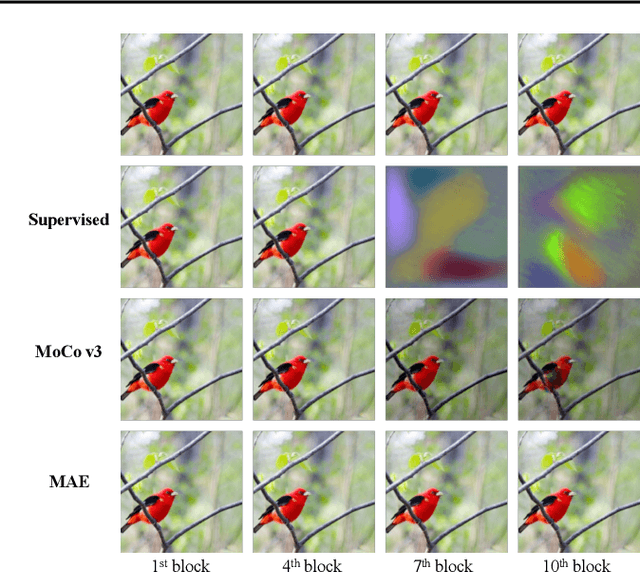

Abstract:Visual Prompt Tuning (VPT) is an effective tuning method for adapting pretrained Vision Transformers (ViTs) to downstream tasks. It leverages extra learnable tokens, known as prompts, which steer the frozen pretrained ViTs. Although VPT has demonstrated its applicability with supervised vision transformers, it often underperforms with self-supervised ones. Through empirical observations, we deduce that the effectiveness of VPT hinges largely on the ViT blocks with which the prompt tokens interact. Specifically, VPT shows improved performance on image classification tasks for MAE and MoCo v3 when the prompt tokens are inserted into later blocks rather than the first block. These observations suggest that there exists an optimal location of blocks for the insertion of prompt tokens. Unfortunately, identifying the optimal blocks for prompts within each self-supervised ViT for diverse future scenarios is a costly process. To mitigate this problem, we propose a simple yet effective method that learns a gate for each ViT block to adjust its intervention into the prompt tokens. With our method, prompt tokens are selectively influenced by blocks that require steering for task adaptation. Our method outperforms VPT variants in FGVC and VTAB image classification and ADE20K semantic segmentation. The code is available at https://github.com/ryongithub/GatedPromptTuning.
Probabilistic Concept Bottleneck Models
Jun 02, 2023Abstract:Interpretable models are designed to make decisions in a human-interpretable manner. Representatively, Concept Bottleneck Models (CBM) follow a two-step process of concept prediction and class prediction based on the predicted concepts. CBM provides explanations with high-level concepts derived from concept predictions; thus, reliable concept predictions are important for trustworthiness. In this study, we address the ambiguity issue that can harm reliability. While the existence of a concept can often be ambiguous in the data, CBM predicts concepts deterministically without considering this ambiguity. To provide a reliable interpretation against this ambiguity, we propose Probabilistic Concept Bottleneck Models (ProbCBM). By leveraging probabilistic concept embeddings, ProbCBM models uncertainty in concept prediction and provides explanations based on the concept and its corresponding uncertainty. This uncertainty enhances the reliability of the explanations. Furthermore, as class uncertainty is derived from concept uncertainty in ProbCBM, we can explain class uncertainty by means of concept uncertainty. Code is publicly available at https://github.com/ejkim47/prob-cbm.
 Add to Chrome
Add to Chrome Add to Firefox
Add to Firefox Add to Edge
Add to Edge